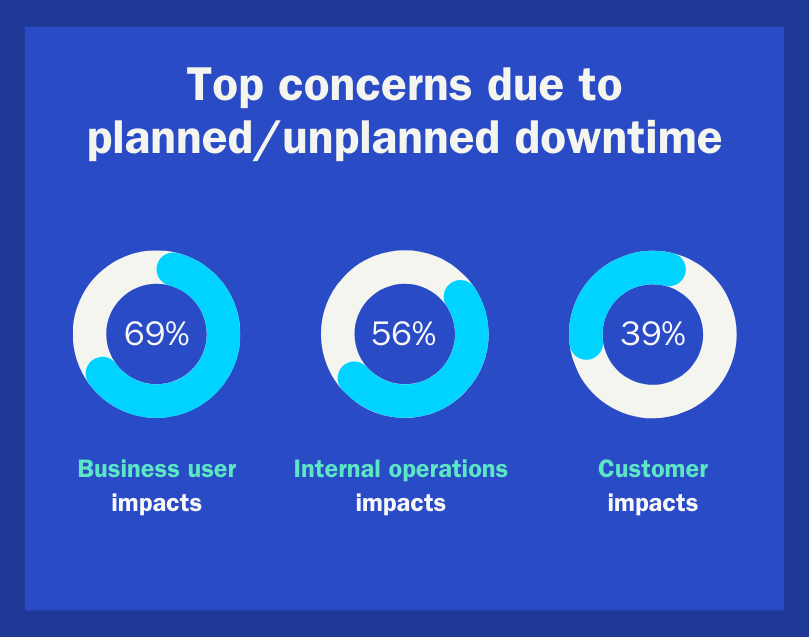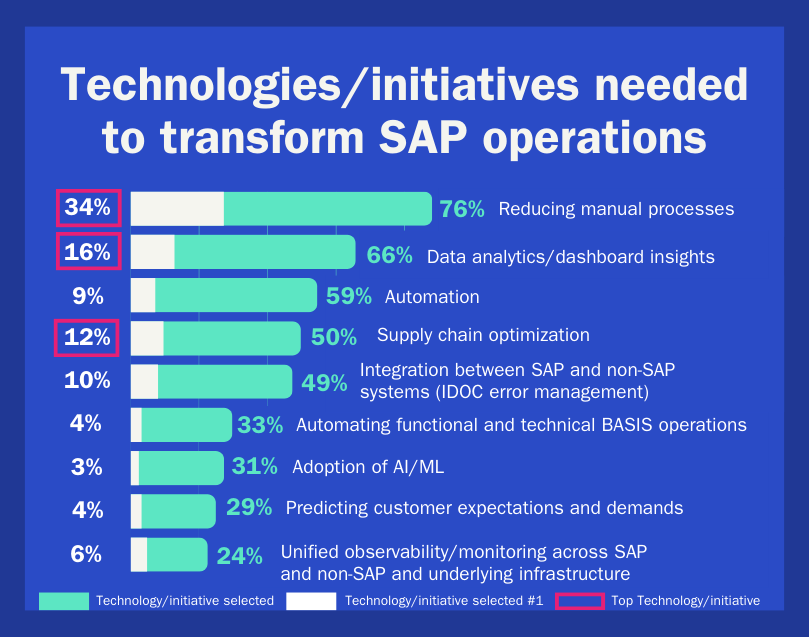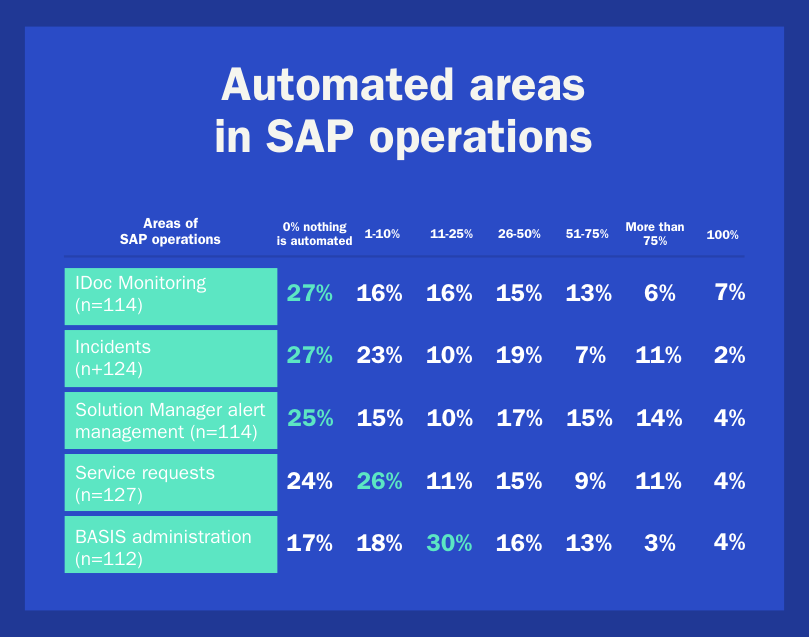
SAP is a tool for automating business processes. Managing SAP solutions, especially with the shift to the cloud-based S/4HANA platform, can be intricate. To explore the concerns of SAP users during operational transformations and automation, a survey was conducted in mid-2023 by Digitate and Americas' SAP Users' Group (ASUG) — the largest network of SAP customers, partners, and professionals in the US. The survey group consisted of 153 SAP users in North America across a range of industries, including consumer products, industrial manufacturing, machinery, and components (IM&C), chemicals, and utilities.
Highlighting the Key Challenges
Respondents to the survey identified a number of key challenges that their businesses faced when managing SAP. These included:
■ Time management: Businesses often spend long hours administering SAP solutions, causing decision-making delays and inefficiencies.
■ Expensive downtimes: Unplanned outages can be costly, affecting other business areas.
■ Resource redirection: Addressing downtimes often diverts essential resources, hindering productivity.
■ Customer frustration: Frequent downtimes can diminish brand trust and customer loyalty.
■ Reporting hurdles: Many find its complex reporting mechanisms challenging, struggling to derive valuable insights.
■ Data gaps: Missing or incomplete data can distort results.
■ Unexpected challenges: Unforeseen system glitches or external factors demand extra troubleshooting.
■ Manual monitoring: Multifaceted SAP components that customers have modified for their unique needs require manual monitoring.
■ Human errors: Mistakes can lead to system outages, disrupting operations.
■ Integration complexity: Connecting SAP to other systems can introduce operational glitches.
Application Downtime Blues
Diving deeper into the results revealed the major concern for respondents was downtime. An overwhelming 90% of the SAP users experienced unplanned SAP application downtime. Furthermore, two-thirds reported that they spent up to 25% of their daily time resolving these unpredictable issues.
While internal downtime impacts were experienced much more than external impacts, business user impacts due to SAP downtime were, unsurprisingly, the overriding concern for respondents. An alarming 69% of businesses reported business user impacts due to downtime, and 56% of those were operational impacts felt internally, while 39% of those surveyed reported a direct impact on customers. External downtime means loss of revenue (28% experienced loss or delay of revenue) and inconvenience for customers.
Integration challenges were identified as the top contributor to unplanned downtime. 40% of businesses cited this as a major problem, which is not surprising given that 60% of organizations use up to 20 tools to monitor different elements of the SAP system. Other significant reported causes of downtime include runtime issues (31%), change requests (25%), and configuration issues (22%)
Furthermore, businesses typically spend four to six hours fixing each downtime problem, leading to less time for other tasks, higher costs, and potential damage to the company's reputation and customer trust.

Operational KPIs and Ticket Resolution
Operational key performance indicators (KPIs) within enterprises are a trusted barometer of the efficiency of SAP operations. Resolving tickets in a timely manner are crucial for overall system health as they impact customer satisfaction, cost control and overall business success. The survey provided some important insights:
■ The KPI of resolving tickets without human intervention is still a distant goal for many, with only 41% reporting they often met it. The largest share of respondents said 10% or less of tickets are resolved automatically. 29% had no tickets resolved automatically.
■ Tickets take an average of three hours to resolve. Long resolution times can upset customers, as delays disrupt services.
■ Ticket requests have grown by 15% year-over-year. This growth indicates more complex SAP operations and can strain IT teams. More tickets can increase operational costs if teams need extra resources.
Leveraging SAP Automation Solutions
Leveraging SAP automation solutions represents uncertainty as almost half of respondents were unable to assess this at their organization. That said, when they were certain, the largest share (42%) responded that their organizations are not leveraging solutions as much as they could. Some of the reasons why organizations are struggling to leverage automation solutions effectively are lack of time and resources, having a plan but no action, and other priorities taking precedence, such as the focus on moving to S/4HANA. There's also a historic resistance to SAP automation solutions, for example, it is seen as too complex or is not yet trusted. Overall, more openness and efforts to adapt new technology, back-end support, and automation across systems are needed to realize benefits.
Automation Can Radically Improve SAP Operations
The survey highlights anticipation for automation to reduce manual processes, with 76% identifying it as crucial for improving SAP operations, and 34% ranking it as the top initiative. Data analytics/dashboard insights and supply chain optimization were also noted as essential technologies/initiatives. While over half recognized the need for automation, only 9% considered it a top priority.
Surprisingly, only 15% currently use artificial intelligence (AI) and machine learning (ML) and monitoring tools, with a third considering it in the future. Despite the momentum towards Generative AI, this remains a low percentage. Notably, 60% use up to 20 tools to monitor SAP systems, indicating a significant opportunity for organizations to enhance business agility and decision-making speed through automated monitoring and AI/ML integration.

So why the disconnect? Why should SAP automation take a back seat?
The survey emphasizes customer focus on automation and SAP S/4HANA. Some are eager to transition for new features, while others must migrate due to mandates.
Businesses see opportunities to enhance SAP operations through technology optimizations, addressing scale, speed, and performance challenges. In the evolving SAP landscape, having the right tools for automation refines operations, reduces human involvement, and minimizes errors, aligning with broader company goals.
Integrating AI/ML and automation into SAP operations drives digital transformation and efficiencies, aided by effective training and suitable tools. Specific tools designed for SAP management tackle challenges, enhancing efficiency, reliability, and agility in day-to-day operations. Offering a comprehensive approach to SAP management, whether it's managing intricate workflows, ensuring data integrity, or optimizing system performance, these tools are well-equipped to confront these challenges head-on, ultimately driving operational excellence.

